The use of Artificial Intelligence in healthcare is revolutionizing the industry by enhancing diagnostic accuracy, treatment customization, and operational efficiency. The healthcare sector is experiencing a transformative shift as artificial intelligence applications gain prominence.
However, understanding the trends in AI in healthcare is crucial. By staying informed and leveraging emerging technologies responsibly, the industry can unlock unprecedented advancements in patient care, medical research, and overall healthcare delivery.
At Aloa, a software outsourcing firm, we recognize the pivotal role of understanding AI trends in the healthcare sector and the development process. At the intersection of technology and healthcare, our team is dedicated to staying informed and leveraging emerging AI technologies responsibly. At Aloa, we provide customized solutions that harness the potential of AI in healthcare to optimize patient outcomes and revolutionize the delivery of medical services.
This blog will dive into the latest trends in AI for healthcare in 2023. In each case, we'll explain the importance of the trends and how they can make a significant difference. By the end, you'll have the knowledge to make the most of these advancements, ensuring you can use AI in health care effectively for better patient care and innovative solutions.
Let's dive in!
Top 8 AI in Healthcare Trends to Watch and Leverage in 2023
In 2023, the use of AI in healthcare trends features advancements empowering the creation of personalized treatment plans and fostering breakthroughs in medical research. Here are the top 8 trends in AI in healthcare for healthcare organizations to watch and leverage:
1. Robotics in Surgery
Robotics in surgery involves using automated instruments and robotic systems to assist medical professionals in performing precise and minimally invasive surgical procedures. It encompasses various applications, from general surgeries to specialized fields like neurology and oncology. This trend is particularly noteworthy in the global surgical robots market, estimated at USD 3.92 billion in 2023.
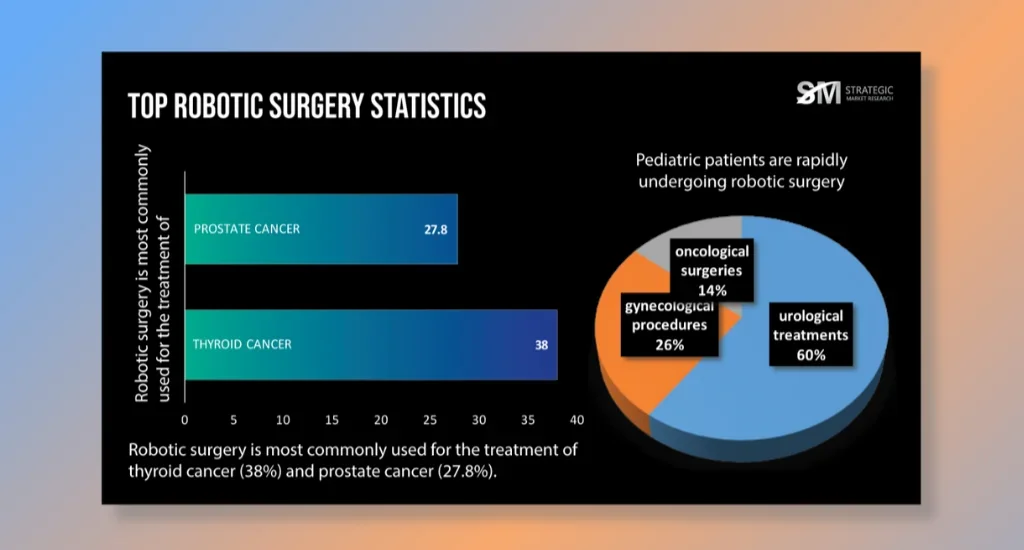
Anticipate a noteworthy growth trajectory with a remarkable Compound Annual Growth Rate (CAGR) of 9.5% from 2024 to 2030. This surge is propelled by various factors, including a shortage of physicians, a rising embrace of automated surgical instruments, and an upswing in hip and knee replacement surgeries.
Notable Features of Robotics in Surgery
- Precision and Accuracy: Surgical robots offer unparalleled precision, enabling surgeons to perform intricate procedures with enhanced accuracy.
- Minimally Invasive Procedures: The adoption of robotics facilitates minimally invasive surgeries, leading to smaller incisions, reduced pain, and quicker recovery times.
- Versatility in Applications: Beyond general surgical procedures, surgical robots find extensive application in oncology and laparoscopy, contributing to diverse healthcare needs.
- Advancements in Neurosurgery: Robotics in neurology is characterized by a rising adoption of neurosurgery, showcasing benefits over traditional techniques, especially in delicate brain procedures.
Considerations for Implementing Robotics in Surgery
In adopting robotics in surgery, critical considerations revolve around patient safety, surgeon proficiency, and seamless integration into existing healthcare workflows. Prioritize comprehensive training programs for surgical teams to optimize their ability to utilize robotic systems, fostering a smooth transition to this advanced technology. Moreover, emphasizes stringent protocols for data security and patient privacy, ensuring that sensitive medical information remains safeguarded throughout the surgical process.
2. Telehealth Integration
Telehealth integration emerges as a pivotal trend in the AI in healthcare sector, revolutionizing the delivery of medical services. This trend is particularly noteworthy in the global telehealth market. Valued at USD 83.5 billion in 2022, the market will experience a robust compound annual growth rate (CAGR) of 24.0% from 2023 to 2030.
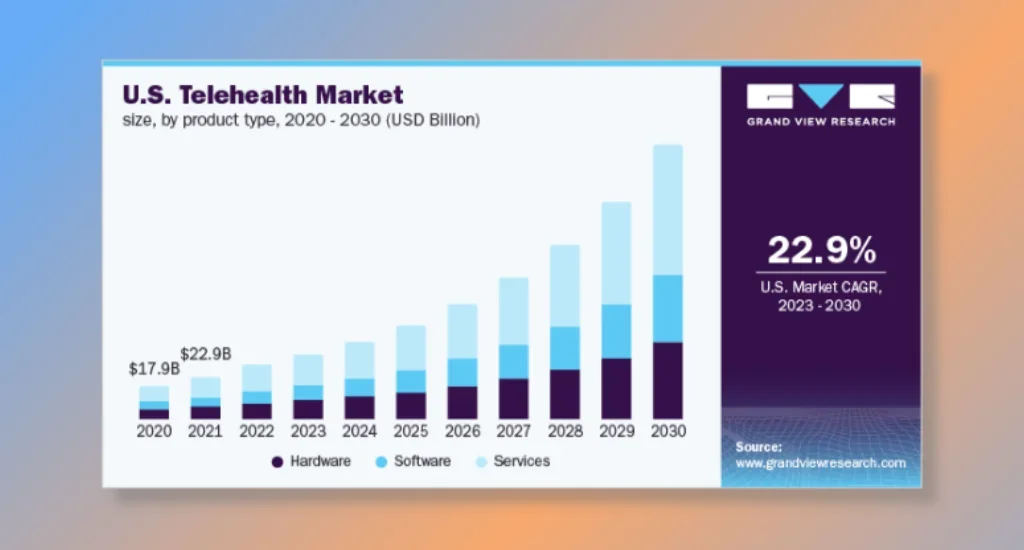
The increasing penetration of the internet, smartphone innovations, and the surge in demand catalyzed by the COVID-19 pandemic are propelling telehealth services to address healthcare gaps conveniently, marking a significant shift from traditional to virtual care methods.
Notable Features of Telehealth Integration
- Convenient Accessibility: Telehealth platforms offer patients convenient access to healthcare services, overcoming geographical barriers and improving healthcare accessibility.
- Remote Monitoring Capabilities: The integration of telehealth allows for continuous remote patient health monitoring, enabling timely interventions and personalized care.
- Virtual Consultations and Medical Diagnoses: Telehealth facilitates virtual consultations and disease diagnoses, reducing the need for in-person visits and optimizing healthcare resources.
- Enhanced Patient Engagement: Integrating telehealth services within health systems enhances patient engagement through interactive platforms, empowering individuals to actively participate in their healthcare journey.
Considerations for Telehealth Integration
In integrating telehealth services, attention should be given to accessibility, patient privacy, and regulatory compliance. Ensuring that telehealth platforms are user-friendly and widely accessible to diverse populations is essential for broadening healthcare reach. Simultaneously, robust security measures must be in place to safeguard patient confidentiality, conforming to established healthcare privacy regulations.
Moreover, staying abreast of evolving telehealth regulations and fostering clear communication between healthcare providers and patients can optimize the seamless integration of telehealth, promoting efficient and secure virtual healthcare delivery.
3. IoT Integration in Healthcare
Integrating the Internet of Things (IoT) in AI in healthcare stands as a transformative trend, redefining the landscape of medical services. IoT in healthcare refers to the interconnection of devices, sensors, and systems to collect, transmit, and analyze patient data, fostering improved healthcare outcomes. Worldwide, the healthcare Internet of Things (IoT) market, with a valuation of USD 252.1 billion in 2022, is expected to experience a steady growth rate of 18% from 2022 to 2032.
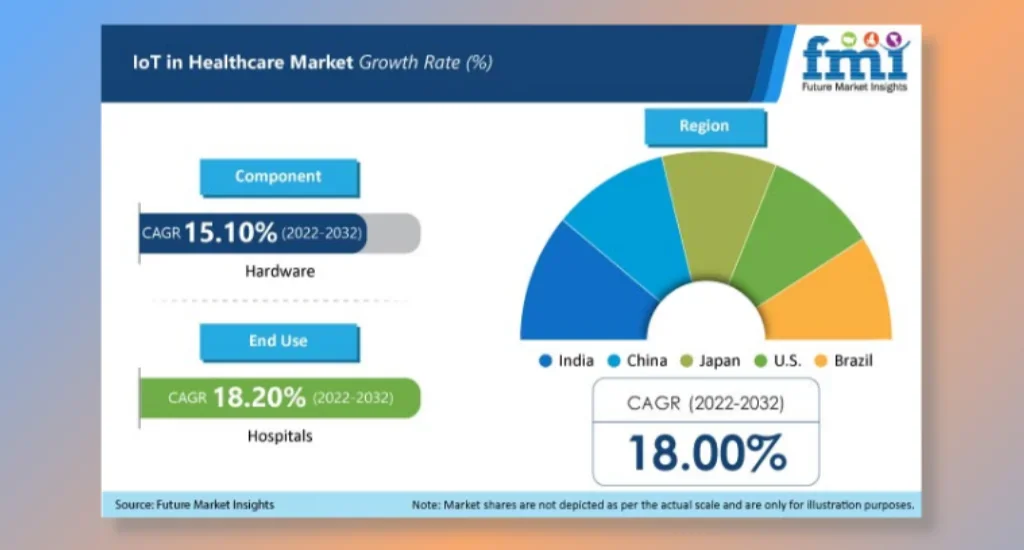
This growth is propelled by the increasing reliance on smartphones, smart devices, and wearables in monitoring patients, coupled with the rising popularity of remote patient monitoring to improve out-of-hospital care.
Notable Features of IoT Integration in Healthcare
- Remote Patient Monitoring: IoT enables continuous monitoring of patients through intelligent medical devices and wearables, allowing healthcare providers to track health metrics remotely.
- Operational Efficiency in Hospitals: Hospitals benefit from improved working and functional efficiency with IoT solutions, aiding in real-time communication, medical records management, and optimization of clinical workflows.
- Enhanced Treatment Outcomes: Enhancing treatment outcomes and IoT integration, coupled with decision support, offers real-time medical data, empowering healthcare professionals to make well-informed decisions.
- Patient-Centric Care Delivery: The adoption of IoT in healthcare fosters patient-centric care delivery, allowing for personalized disease management and improved overall patient experience.
Considerations for IoT Integration in Healthcare
When implementing IoT integration in AI in healthcare, key considerations include data security, interoperability, and patient consent. Safeguarding the vast amount of sensitive health data transmitted through IoT devices is paramount, necessitating robust encryption and authentication measures to prevent unauthorized access. Interoperability standards should be prioritized to ensure seamless communication and data exchange among various IoT devices and healthcare systems, fostering a cohesive and efficient healthcare ecosystem.
4. AI for Genomic Analysis
The application of Artificial Intelligence in Genomic Analysis is transforming healthcare, utilizing advanced algorithms to interpret vast genomic data from cutting-edge sequencing technologies.
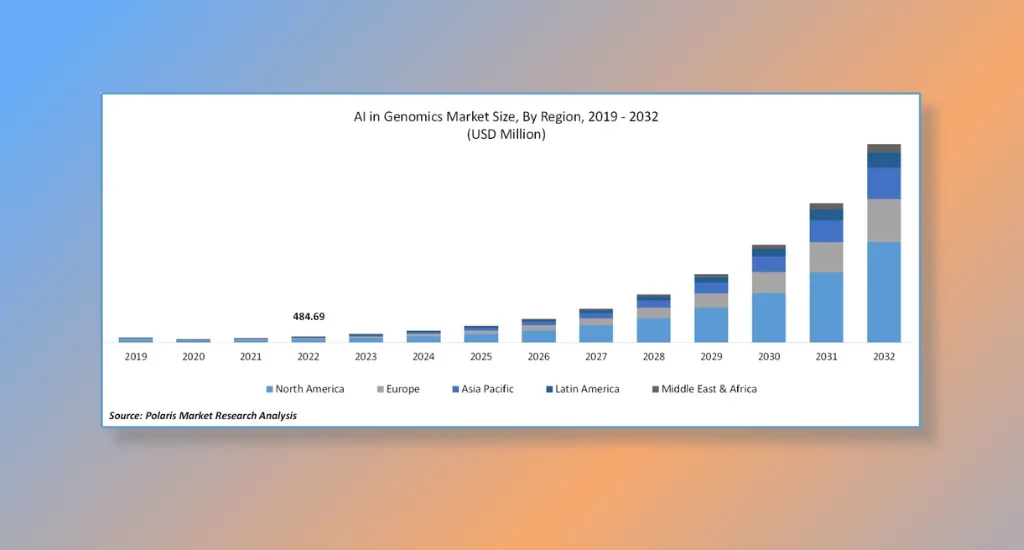
With the global genomics market reaching USD 32.65 billion in 2023, it is poised for substantial growth at a robust compound annual growth rate (CAGR) of 16.5% from 2024 to 2030. This growth is fueled by the increasing demand for gene therapy, personalized medicine, drug discovery, and addressing the growing incidence of inherited cancers.
Noteworthy collaborations and partnerships among market players, such as the collaboration between Illumina, Inc., and Allegheny Health Network, showcase the industry's commitment to advancing patient care through genomic analysis.
Notable Features of AI for Genomic Analysis
- Precision Genome Editing Techniques: AI in healthcare facilitates the application of precision genome editing techniques like CRISPR-Cas gene technology for managing inherited common diseases and providing targeted and effective treatments.
- Enhanced Disease Understanding and Drug Discovery: The integration of AI in genomic analysis aids in understanding rare diseases, contributing to drug discovery by identifying potential genetic mutations associated with these conditions.
- Personalized Treatment Plans: Artificial intelligence is instrumental in developing customized treatment plans by analyzing an individual's genetic makeup, enabling doctors to prescribe the most effective treatments based on genomic data.
- Extraction of Biologically Relevant Information: AI addresses the challenge of handling massive genomic data by extracting biologically or clinically relevant information from DNA sequencing and Electronic Health Records (EHRs), providing meaningful insights for researchers and clinicians.
Considerations for AI for Genomic Analysis
The adoption of AI for genomic analysis requires rigorous data accuracy checks, a robust ethical framework for privacy protection, and an emphasis on result interpretability. Precision in genomic data, ethical considerations such as privacy safeguards, and ensuring interpretable AI-driven insights are essential for harnessing the full potential of genomic analysis in personalized medicine.
5. AI-Enabled Robotic Process Automation (RPA)
AI-Enabled Robotic Process Automation (RPA), a transformative trend reshaping business workflows, utilizes artificial intelligence to automate repetitive processes and streamline administrative tasks.
The global RPA market, valued at USD 2.3 billion in 2022, is projected to witness an impressive CAGR of 39.9% from 2023 to 2030. The COVID-19 pandemic accelerated RPA adoption as businesses worldwide sought automated solutions to streamline operations.
Integration with advanced technologies like Machine Learning (ML), Optical Character Recognition (OCR), and analytics is poised to enhance RPA's complexity, enabling increased performance and intelligent Automation, with an anticipated elimination of approximately 40% of service desk interactions by 2025.
.webp)
Notable Features of AI-Enabled RPA in Healthcare
- Enhanced Healthcare Workflow Efficiency: AI-enabled RPA streamlines administrative tasks, allowing healthcare professionals to focus more on patient care and less on manual processes.
- Improved Accuracy in Data Processing: By reducing human error, AI-driven RPA ensures precise handling of patient data, leading to better-informed medical decisions.
- Adaptive to Regulatory Changes: AI in healthcare RPA helps healthcare systems comply with evolving regulations by quickly adapting workflows to meet new standards and requirements.
- Integration with Electronic Health Records (EHR): AI-enabled RPA seamlessly integrates with EHR systems, facilitating efficient data exchange and enhancing overall interoperability.
Considerations for AI-Enabled RPA
Integrating AI-enabled Robotic Process Automation (RPA) in healthcare necessitates focusing on workflow efficiency, data security, and seamless human-machine collaboration. Emphasizing workflow efficiency involves identifying repetitive and time-consuming tasks suitable for Automation, allowing healthcare professionals to redirect their efforts toward more complex and patient-centric activities.
Concurrently, stringent measures must be implemented to ensure the security of sensitive patient data, leveraging AI to enhance data protection and prevent unauthorized access. Lastly, fostering seamless collaboration between AI-driven RPA systems and healthcare professionals is essential, emphasizing user-friendly interfaces and comprehensive training to optimize the integration and improve overall healthcare service delivery.
6. Blockchain for Healthcare Data Security
Blockchain for AI in healthcare is a burgeoning trend, harnessing blockchain technology to fortify the integrity and confidentiality of healthcare data. Witness an extraordinary journey in the global blockchain technology market, initially valued at USD 10.02 billion in 2022.
Brace for an impressive Compound Annual Growth Rate (CAGR) of 87.7% from 2023 to 2030, indicating a remarkable surge in this dynamic landscape. Blockchain's decentralized and tamper-resistant ledger system addresses the escalating demand for secure and transparent transactions, particularly in healthcare.
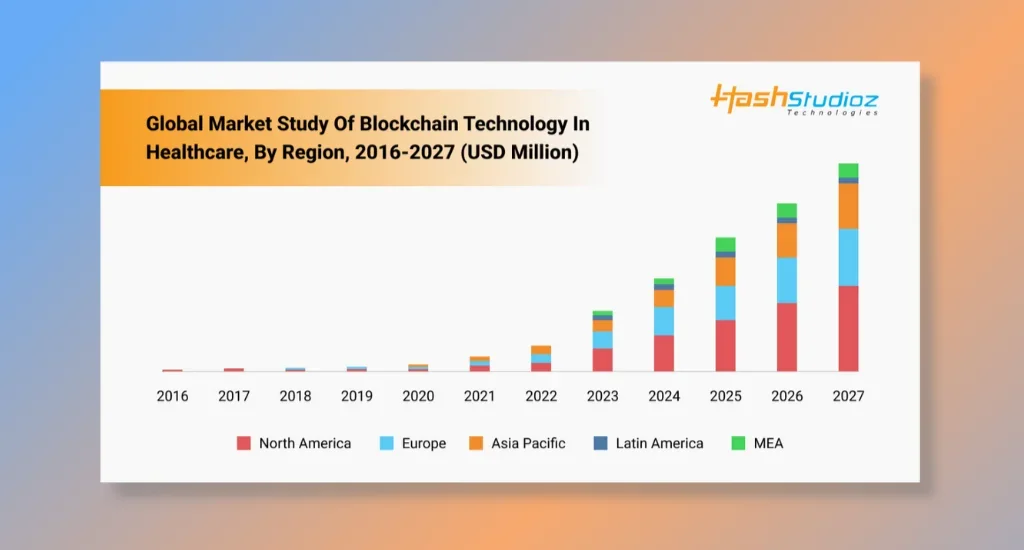
There is a growing demand for digitalization within the healthcare industry, with organizations increasingly adopting blockchain solutions to improve security and transparency. The healthcare segment is expected to witness the highest growth, driven by stringent data protection regulations, the surge in digitalization due to the COVID-19 pandemic, and the imperative to safeguard consumer information.
Notable Features of Blockchain for Healthcare Data Security
- Immutable Data Integrity: Blockchain ensures data integrity in healthcare by providing an immutable ledger that prevents unauthorized alterations, maintaining the accuracy and reliability of medical records.
- Enhanced Data Privacy Compliance: Blockchain facilitates compliance with data protection regulations, such as the GDPR, by offering a secure and transparent framework for handling patient information, reducing the risk of data breaches.
- Real-time Traceability of Health Records: The technology enables real-time traceability of health records, ensuring a comprehensive and auditable history of patient data access and enhancing accountability and transparency.
- Secure Interoperability: Blockchain fosters secure interoperability among diverse healthcare systems, allowing seamless and secure sharing of patient data across different entities improving overall healthcare coordination and efficiency.
Considerations for Blockchain for Healthcare Data Security
Implementing Blockchain for healthcare data security necessitates focusing on transparency, tamper-proof record-keeping, and interoperability. The inherent openness of Blockchain ensures that all participants in the healthcare ecosystem can access a secure and unalterable record of transactions, enhancing trust among stakeholders.
Tamper-proof record-keeping is crucial to safeguard the integrity of sensitive healthcare data, as Blockchain's decentralized nature makes it resistant to unauthorized alterations.
Furthermore, prioritizing interoperability ensures that Blockchain technology seamlessly integrates with existing healthcare systems, facilitating secure data exchange and enhancing the efficiency of healthcare operations while maintaining the highest data security standards.
7. Chatbots and Virtual Health Assistants
Chatbots and Virtual Health Assistants represent a transformative trend in healthcare, leveraging artificial intelligence to enhance patient engagement and streamline healthcare services. The global chatbot market worth USD 5,132.8 million in 2022 is estimated to have a compound annual growth rate of 23.3% from 2023 to 2030.
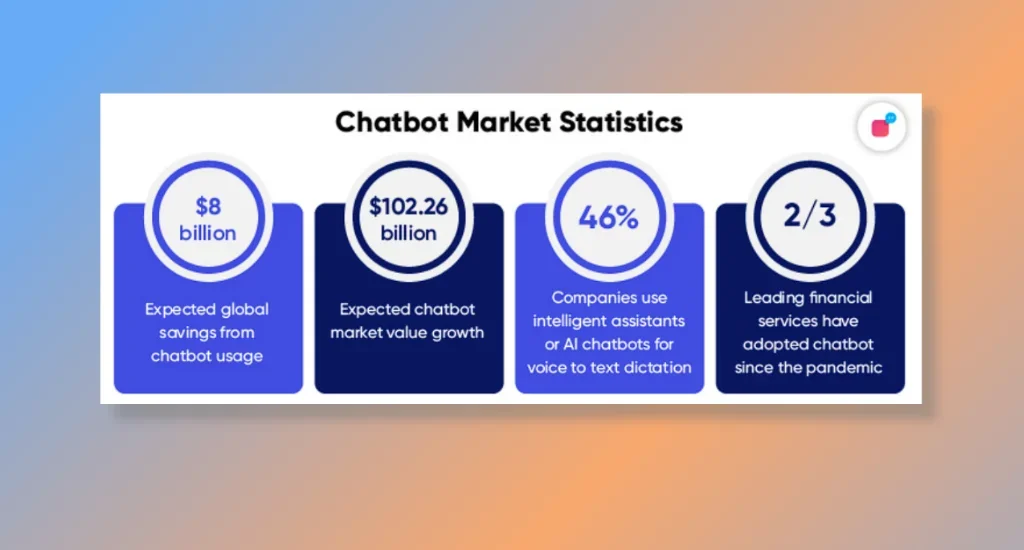
These AI-driven applications engage in textual conversations with users. They are integrated into messaging platforms, facilitating interactions in various sectors, including healthcare. The AI in healthcare industry has witnessed substantial adoption of chatbots, particularly in North America, which accounted for the largest market share of around 30.72% in 2022.
Amid the challenges posed by the COVID-19 pandemic, businesses, including medical and healthcare verticals, have embraced hipaa compliant chatbots to enhance customer service, offer COVID-19 advice, and ensure a seamless experience for users.
Notable Features of Chatbots and Virtual Health Assistants
- 24/7 Patient Support: Chatbots provide continuous, around-the-clock support to patients, ensuring accessibility to information and assistance at any time.
- Enhanced Efficiency in Healthcare Operations: Chatbots improve operating efficiency by automating routine customer service activities, reducing response times, and optimizing resource allocation.
- Adoption in Crisis Management: The COVID-19 pandemic has accelerated the adoption of chatbots in healthcare crisis management, enabling businesses to provide timely information, advice, and support.
- Personalized Patient Interaction: Chatbots leverage AI and machine learning algorithms to offer personalized interactions, adapting responses based on user behavior and preferences, leading to improved patient satisfaction.
Considerations for Chatbots and Virtual Health Assistants
Implementing Chatbots and Virtual Health Assistants in healthcare requires carefully balancing personalized patient interactions, data security, and adaptability. Prioritizing personalized patient interactions involves designing chatbots to understand and respond to diverse patient needs, fostering a more engaging and empathetic healthcare experience.
Additionally, robust data security measures, especially regarding medical history, are paramount to protect sensitive patient information exchanged during virtual interactions, maintaining trust and compliance with healthcare privacy regulations.
Lastly, the adaptability of Chatbots and Virtual Health Assistants should be emphasized, allowing for seamless integration into various healthcare workflows and continuous refinement based on user feedback, technological advancements, and evolving healthcare requirements.
8. Natural Language Processing (NLP) for Data Analysis
Natural Language Processing (NLP) for Data Analysis is a pivotal trend in healthcare, underpinned by its significant role in artificial intelligence. With a global market size of USD 16.08 billion in 2022 and an anticipated compound annual growth rate (CAGR) of 38.4% from 2023 to 2032, NLP finds applications in consumer chatbots, digital assistants, sentiment analysis, text analysis, voice sense (speech analytics), and change effect analysis. This growth is fueled by the swift acceptance of novel technological advancements and the escalating demand for data management, especially in complex businesses.
In the AI in healthcare sector, NLP tools, predictive analytics, automation tools, and cloud-based software contribute to a leading % market share in 2022. Healthcare researchers leverage NLP to monitor online comments during the COVID-19 pandemic. The Asia Pacific region is anticipated to lead, driven by increasing smartphone usage, rapid technological advancements, and government initiatives, particularly in robotics and IT infrastructure.
%2520for%2520Data%2520Analysis.webp)
Notable Features of NLP for Data Analysis
- Sentiment Analysis Precision: NLP systems offer high precision in sentiment analysis, allowing businesses to discern and respond effectively to consumer emotions, ultimately enhancing customer experience.
- Multilingual Capability: NLP tools excel in processing multiple languages, enabling seamless communication and data analysis across diverse linguistic landscapes.
- Real-time Data Processing: NLP facilitates real-time analysis of vast datasets, empowering businesses to extract actionable insights promptly and make informed decisions.
- Contextual Understanding: Advanced NLP technologies exhibit a nuanced understanding of context, enabling more accurate interpretation of user queries and providing relevant responses in varied conversational contexts.
Considerations for NLP for Data Analysis
Implementing Natural Language Processing (NLP) for data analysis requires a careful focus on language nuances, algorithm accuracy, and user-friendly interfaces. Addressing language nuances is vital to ensure that NLP algorithms can accurately interpret and analyze the intricacies of human language, minimizing the risk of misinterpretation. Meanwhile, refining algorithm accuracy is crucial for extracting meaningful insights from unstructured data, enhancing the reliability and relevance of the analysis.
Additionally, user-friendly interfaces play a pivotal role in the successful implementation of NLP, as intuitive interactions empower users with varying levels of technical expertise to effectively leverage the power of natural language processing in their data analysis efforts.
How to Stay Ahead of the Curve in AI in Healthcare Trends
In recent years, the healthcare industry has undergone a transformative shift with the potential applications of AI technologies. Staying ahead in AI in healthcare trends is paramount for professionals and organizations looking to drive innovation. Here are five essential steps to ensure you stay at the forefront of this dynamic sector:
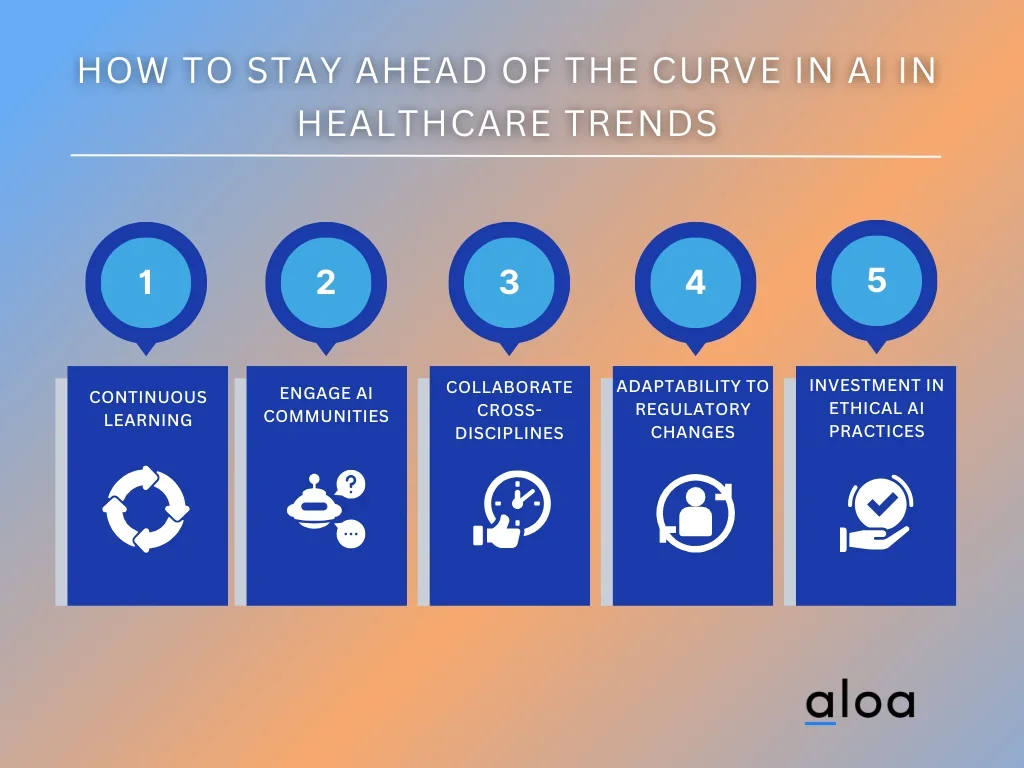
Continuous Learning and Skill Development
Staying ahead in AI in healthcare requires a commitment to continuous learning. Professionals should continue education to keep abreast of the latest technologies, methodologies, and applications.
Active Participation in AI Communities
Joining and actively participating in AI and healthcare communities, especially those involving AI systems, is essential. Networking with peers, sharing insights, and learning from others' experiences can provide valuable perspectives and inform you about emerging trends.
Embrace Cross-Disciplinary Collaboration
Given the interdisciplinary nature of AI in healthcare, fostering collaboration between data scientists, healthcare professionals, and technology experts is crucial. Building cross-disciplinary teams can lead to more comprehensive and effective AI solutions.
Adaptability to Regulatory Changes
Staying ahead involves staying compliant. Healthcare professionals and AI practitioners must stay informed about evolving regulations and standards in the healthcare and AI sectors to ensure that their solutions align with legal and ethical considerations.
Investment in Ethical AI Practices
As the ethical implications of AI become more pronounced, staying ahead means prioritizing ethical considerations. Integrating responsible AI practices, ensuring transparency, and addressing bias is essential for building trust in AI applications within the healthcare domain.
Key Takeaway
As the landscape of AI in healthcare continues to evolve, key trends such as the application of Artificial Intelligence (AI) in predictive analytics, early detection methods, and advancements in robotic surgery are shaping the industry's future. These trends promise transformative impacts on diagnostics, treatment personalization, drug administration, and operational efficiency, ultimately improving health outcomes.
Staying informed about these developments is essential for healthcare professionals and organizations seeking to optimize patient care and navigate the dynamic landscape of AI in healthcare.
Explore the forefront of AI in healthcare with Aloa. Connect with us at [email protected], and let's shape the future of healthcare through innovative AI solutions.

